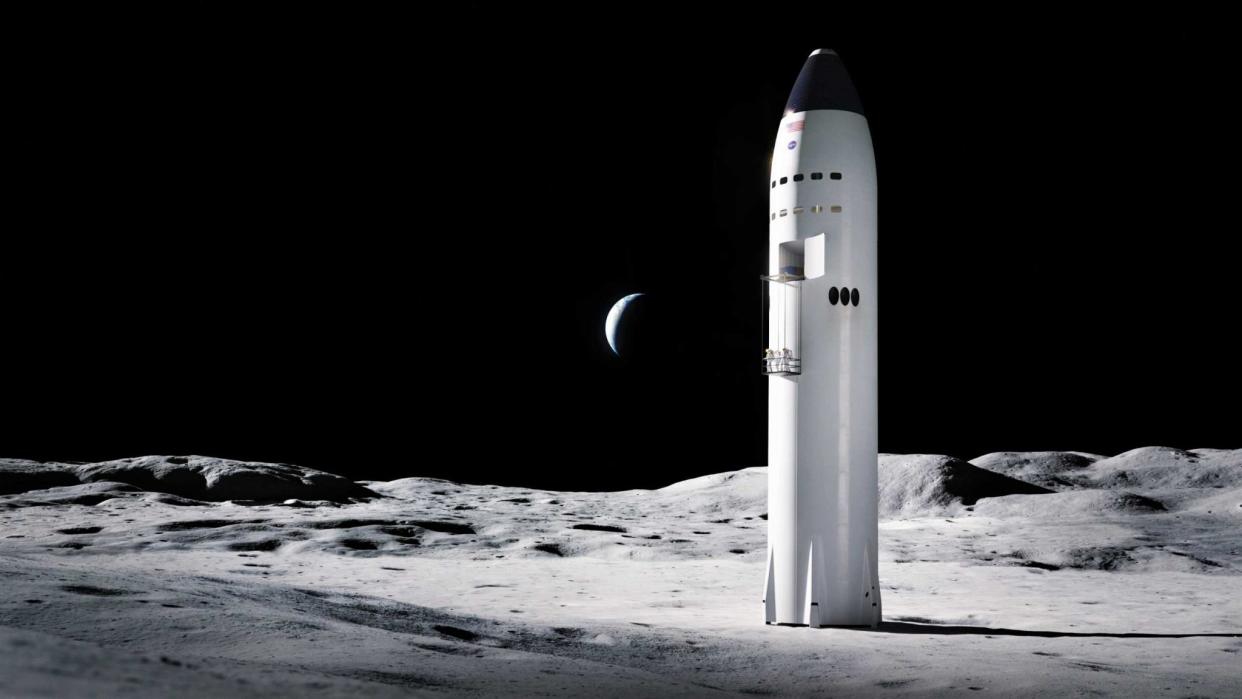SpaceX Starship problems likely to delay Artemis 3 moon mission to 2026, NASA says

NASA is worried that SpaceX's giant new Starship vehicle won't be ready to carry astronauts to the surface of the moon in late 2025, as currently planned.
In 2021, the agency selected Starship — the biggest and most powerful rocket ever built — to be the first crewed lunar lander for its Artemis program of moon exploration.
Starship will put astronauts down near the ice-rich lunar south pole on the Artemis 3 mission, in humanity's first return to the moon since the Apollo program ended in 1972. Artemis 3 is currently targeted to lift off in December 2025, but it's unlikely Starship will be able to meet that timeline, NASA officials said.
December 2025 "is our current manifest date, but with the difficulties that SpaceX has had, I think that's really, really concerning," Jim Free, NASA's associate administrator for exploration systems development, said on Wednesday (June 7) during a joint meeting of the U.S. National Academies' Aeronautics and Space Engineering Board and its Space Studies Board.
"So, you can think about that slipping probably into '26," he added.
Related: NASA's Artemis 3 mission: Landing humans on the moon
A fully stacked Starship launched for the first time ever in April, soaring high into the skies above South Texas on an epic, highly anticipated test mission.
The flight aimed to send Starship's upper stage most of the way around Earth, wrapping up with an ocean splashdown near Hawaii. But the vehicle's two stages failed to separate as planned, and SpaceX ordered Starship's destruction over the Gulf of Mexico less than four minutes after liftoff.
It's unclear when Starship will fly again; several boxes must be checked first. For example, the U.S. Federal Aviation Administration (FAA) is still investigating the launch mishap, with SpaceX's help. And a coalition of environmental groups is suing the FAA, claiming the agency didn't properly assess the damage Starship launches could inflict on the surrounding ecosystem.
A relatively quick return to flight would be necessary for Artemis 3 to have any chance of meeting the 2025 target, for, as Free noted, SpaceX must conduct a number of Starship launches before the vehicle starts carrying Artemis astronauts.
Each Starship that heads for the moon, for instance, must be fueled in a "depot" in Earth orbit by several other Starship tanker vehicles. And SpaceX will send an uncrewed Starship to the lunar surface and back ahead of Artemis 3, to demonstrate the craft's safety and readiness for crewed flight.
"If you figure they need a number of launches to do their depot for our crewed flight, they need a number of launches to do the demo, they need a number of launches just to get flying — they have a significant number of launches to go, and that of course gives me concern about the December of 2025 date," Free said.
The Artemis program aims to establish a permanent, sustainable human presence on and around the moon by the end of the 2020s. NASA believes the skills and knowledge gained by achieving this will help the agency send astronauts to Mars in the late 2030s or early 2040s.
One Artemis mission has lifted off to date — Artemis 1, which sent an uncrewed Orion capsule to lunar orbit and back last fall. Artemis 2 is slated to launch astronauts around the moon in late 2024, again using Orion and NASA's Space Launch System (SLS) megarocket, the latter of which debuted on Artemis 1. (Orion had flown once before, on a test flight to Earth orbit in 2014.)
SLS and Orion will be involved in Artemis 3 as well. The duo will carry four astronauts off Earth; two of those spaceflyers will then board Starship for the trip to the lunar surface and back.
RELATED STORIES:
— Starship and Super Heavy: SpaceX's Mars-colonizing transportation system
— NASA's Artemis program: Everything you need to know
— Relive SpaceX's explosive 1st Starship launch in incredible photos
An Artemis 3 delay to 2026 would hardly be surprising; the mission is ambitious, after all, and will employ newly developed and highly complex pieces of space hardware.
Indeed, the December 2025 date is already a slip from the original target: In March 2019, the Trump administration instructed NASA to put astronauts on the moon by the end of 2024. This timeline was widely viewed as overly aggressive, as a November 2021 report by the NASA Office of Inspector General (OIG) noted.
"NASA's goal to land astronauts on the moon's south pole in late 2024 faces multiple significant challenges including major technical risks, an unrealistic development schedule and lower-than-requested funding levels. As a result, the 2024 date will likely slip to 2026 at the earliest," wrote the authors of the OIG report.
You can read that report, titled "NASA's Management of the Artemis Missions," here.
Starship isn't the only private vehicle that NASA plans to use as a crewed moon lander, by the way. Last month, the agency announced that it had selected Blue Origin, Jeff Bezos' spaceflight company, to provide a second Artemis human landing system.

